Perpetual Calendars: What They Do And What Most Of Them Don’t Do
This year is a leap year because 2020 is evenly divisible by four. But not every year divisible by four is a leap year: secular years, which bring our Gregorian calendar back in line with the solar year, are not leap years and have only 28 days in February. These are years like 1700, 1800, 1900, 2100, 2200, 2300.
The next secular year is 2100, and only a handful of watches take this anomaly into account.
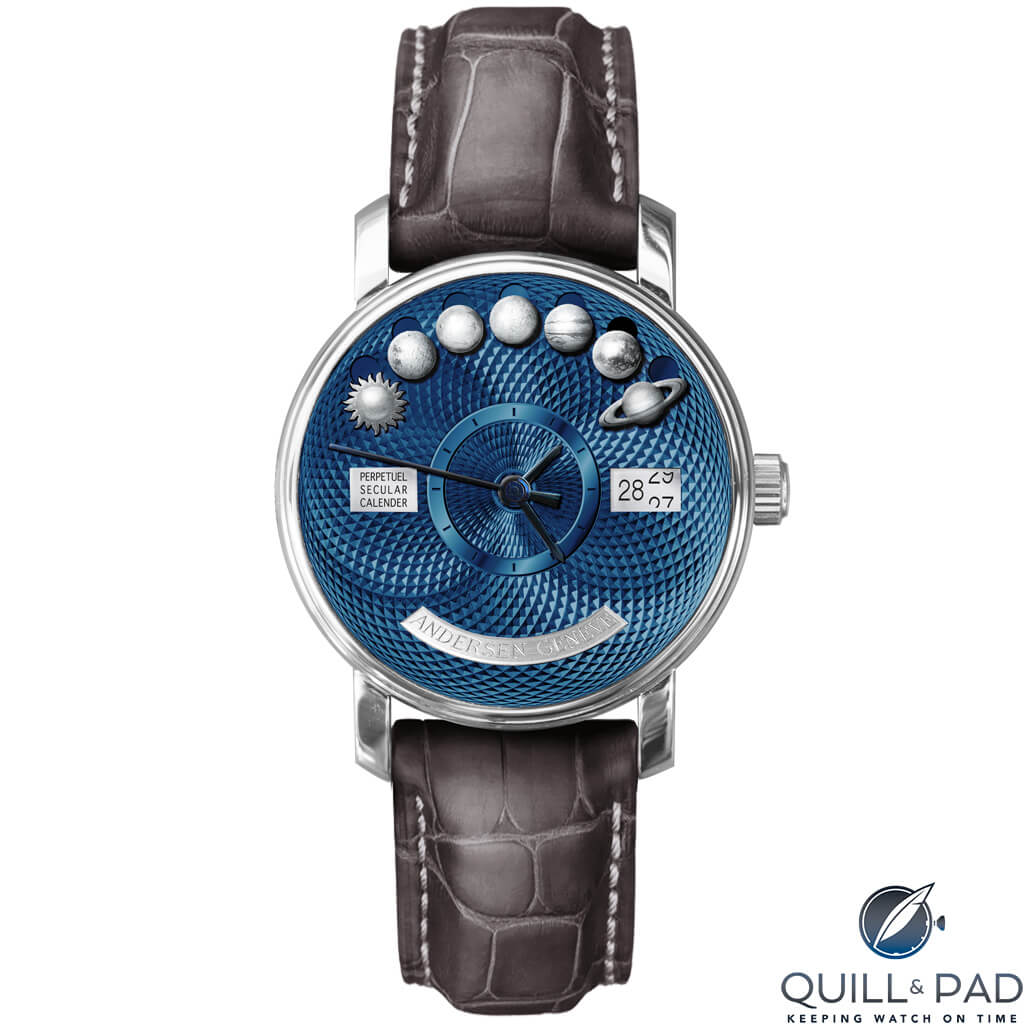
Andersen Genève Perpetuel Secular Calendar “20th Anniversary” with blue gold dial
Those lucky enough to have a watch with a perpetual calendar are in good shape for recognizing garden-variety leap years. The rest of us with simple date windows and other calendar types have to correct the date at the end of February to March 1. Not an arduous task.
Watch owners, collectors, and buyers choose the more complicated annual or perpetual calendars for a variety of reasons. Convenience is one (but that feels rather weak to me).
Then there’s the prestige factor. Calendar complications are cool. They raise the status of the watch (and the owner) another notch. And let’s face it: having a watch that knows when it’s a leap year is a horological achievement that not everyone has.
There are many watch manufacturers offering annual calendars, which automatically account for every month length except February when the date has to be adjusted forward to March 1.
Far fewer brands offer perpetual calendars, which require no adjustment at the end of February. Among them are Patek Philippe, Audemars Piguet, Franck Muller, De Bethune, A. Lange & Söhne, Breguet, Bovet, Greubel Forsey, Jaquet Droz, and Jaeger-LeCoultre.
These are prestigious names. The value of their perpetual calendar pieces is reflected in their price.
Basic date
Watch calendars generally come in three flavors, with a rare fourth only manufactured by a small handful.
First, there’s the basic date. Often it’s the only complication on the watch, and usually comes in the form of a date window or hand pointing to a scale.
The movement makes no automatic adjustment for the differing number of days in the months, and without intervention the date wheel will always run to 31 days.
Annual calendar
An annual calendar movement knows what months within the year have 30 or 31 days and presents them accordingly. Cool.
The Rolex Sky-Dweller is a good example of an annual calendar. However, as sophisticated as this piece is, the lucky owners just had to manually adjust for February 29 since 2020 is a leap year. As I write this, my own Sky-Dweller still thinks it’s February 31. I’ll have to refresh my memory of how to work that Command Bezel to set things right.
Thankfully, annual calendar owners won’t have to go through this for another year. Most brands offering annual calendars now have simplified the adjustment part to the point where it’s a snap.
Most annual calendar watches come with both month and date indications – be they windows or subdials. Patek Philippe introduced the first annual calendar in 1996 with its Reference 5035. Since then, manufacturers have become so adept at this complication, they’ve added other embellishments. You’ll find many annual calendar watches with complications such as moon phases and chronographs.
Perpetual calendar
Thomas Mudge created the earliest known perpetual calendar pocket watch in 1762. It wasn’t until 1925, though, that Patek Philippe produced the first perpetual calendar wristwatch.
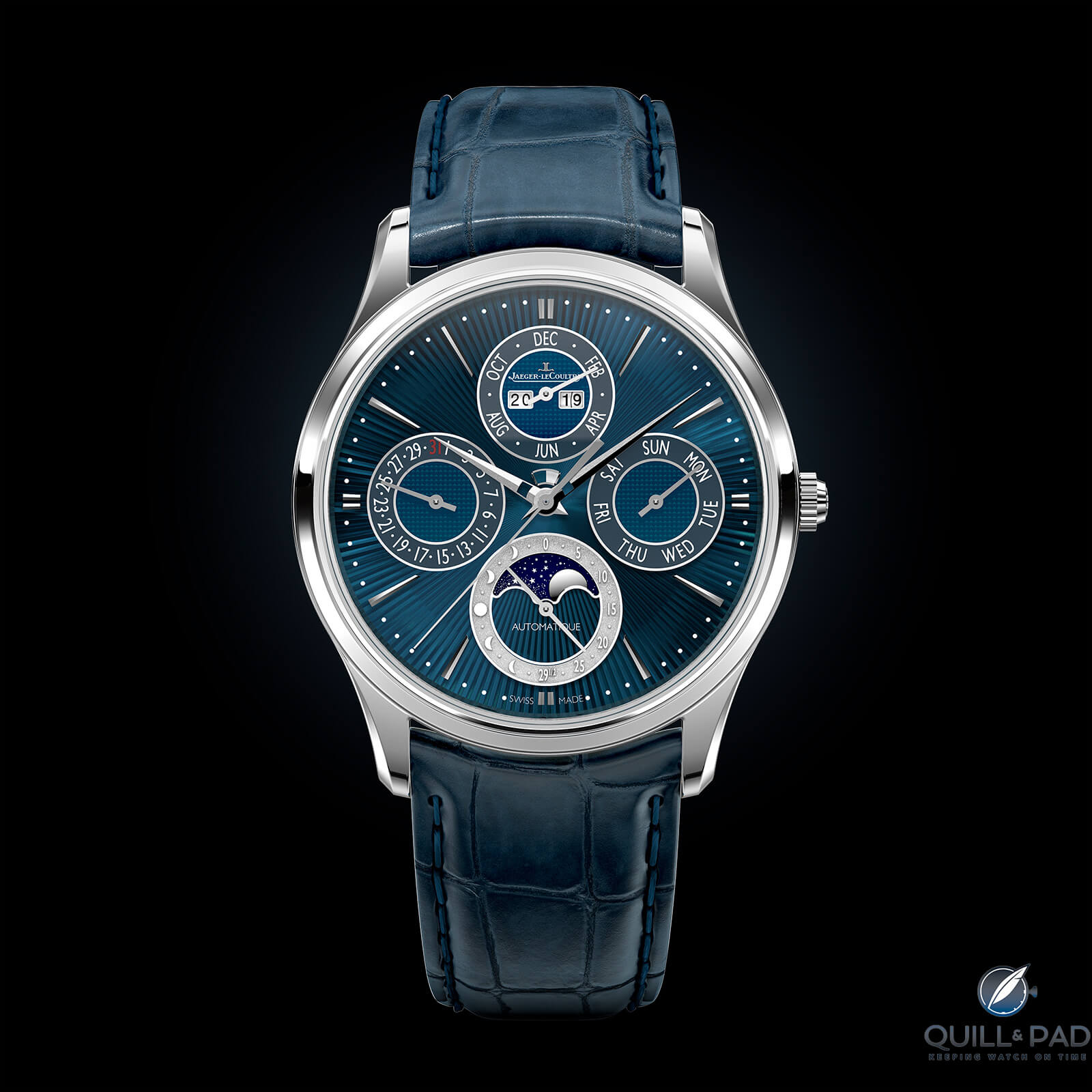
Jaeger-LeCoultre Master Ultra Thin Perpetual Enamel
The perpetual calendar is a very complicated movement. A perpetual calendar does everything the basic date and annual calendars do, plus it accounts for February’s unique length and leap years. Many perpetual calendars also show the leap year rhythm, which is often displayed in a small subdial showing the four-year leap cycle with a hand indicating where we are.
Other perpetual calendars display this critical information using a small aperture identifying the current year in the leap year cycle using, I, II, III, and IV.
Some, like the Jaeger-LeCoultre Master Ultra Thin Perpetual Calendar, show the actual year in four digits instead of the four-year leap cycle subdial.
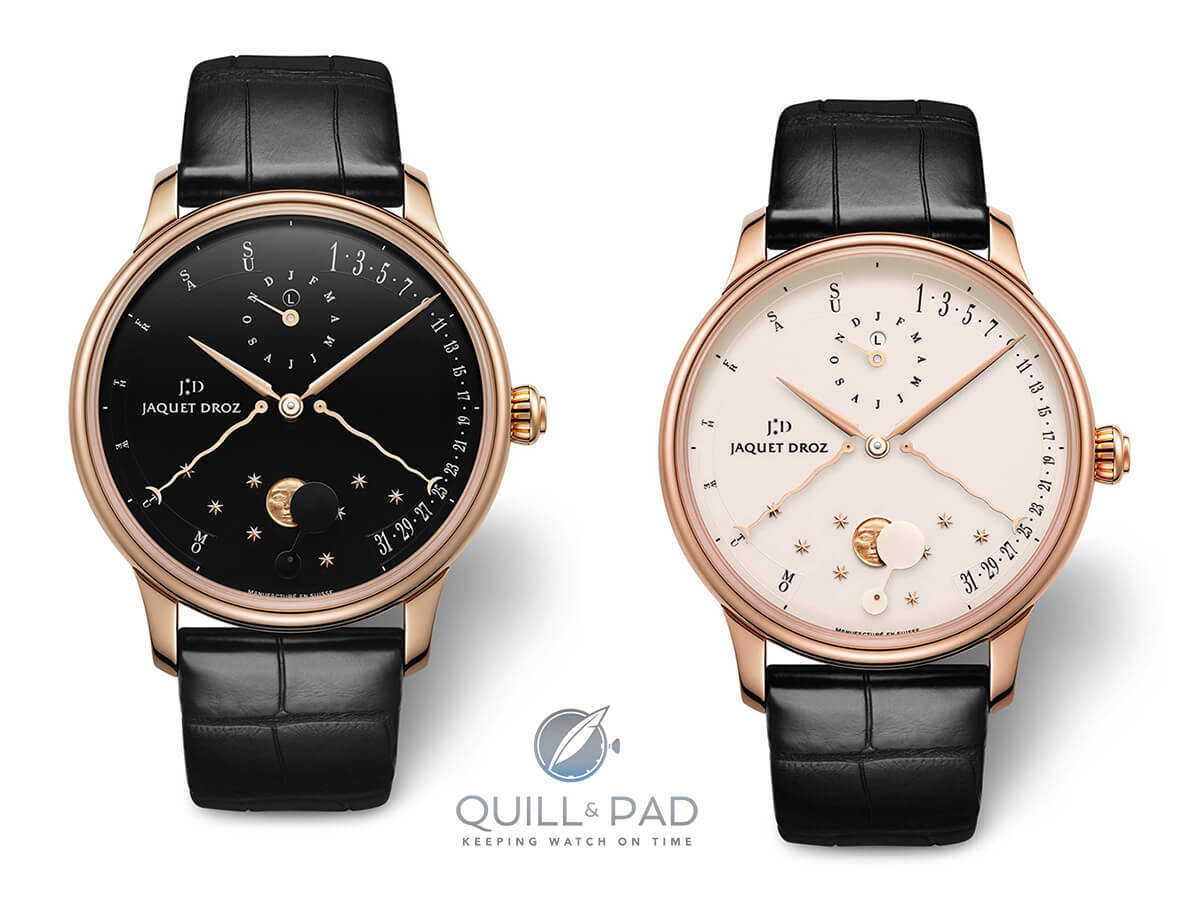
Jaquet Droz Perpetual Calendar Éclipse with black and ivory oven fired enamel dials
Jaquet Droz offers several perpetual calendars in retrograde dial configurations, a popular recent variation being the Perpetual Calendar Éclipse.
So does IWC. Its Da Vinci perpetual is a quintessential favorite and was also the first to show the year in four digits. With this information, the perpetual knows the differing lengths of every month both in and out of leap year.
As capable as these perpetual calendars are, they have a flaw: secular or centurial years (2100, 2200, 2300, 2400). These would normally be leap years since they’re evenly divisible by four. However, when Pope Gregory XIII blessed the Gregorian calendar in 1582, these years were deemed not to be leap years because they are evenly divisible by 100. However, those centurial years evenly divisible by 400 were deemed to be leap years. For example, the years 1700, 1800, and 1900 were not leap years, but the years 1600 and 2000 were leap years.
As a result, almost all perpetual calendars must be manually adjusted in centurial or secular years.
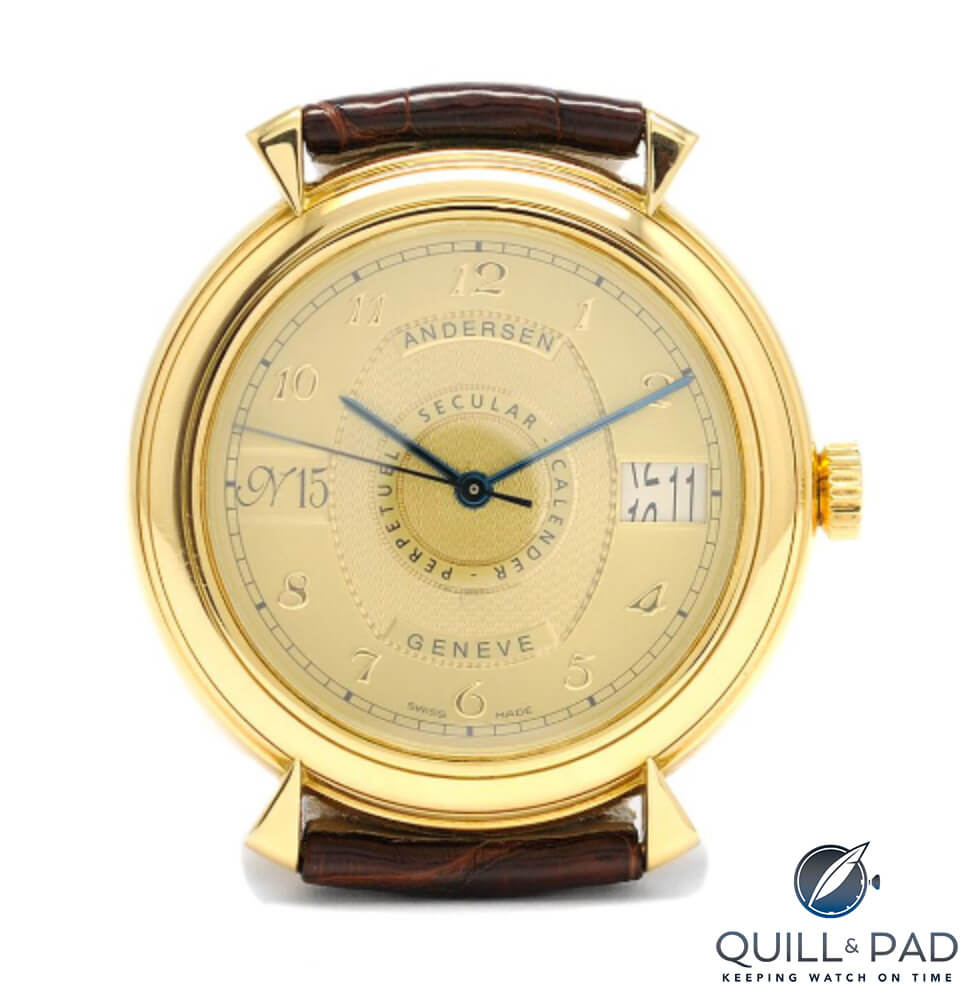
Perpetual secular calendar by Svend Andersen (photo courtesy www.kaplans.com)
To my knowledge, there are only two watches that account for secular years. One is the previously mentioned Andersen Genève Perpetual Secular Calendar. It is programmed for leap and secular years to the year 2400. On its face, it looks like a normal three-handed watch with a date complication. But look on the case back: through the sapphire crystal viewing window all is revealed.
At least all that relates to dates through 2400. This individually made watch, which independent watchmaker Andersen makes only upon order, retails for around $60,000.
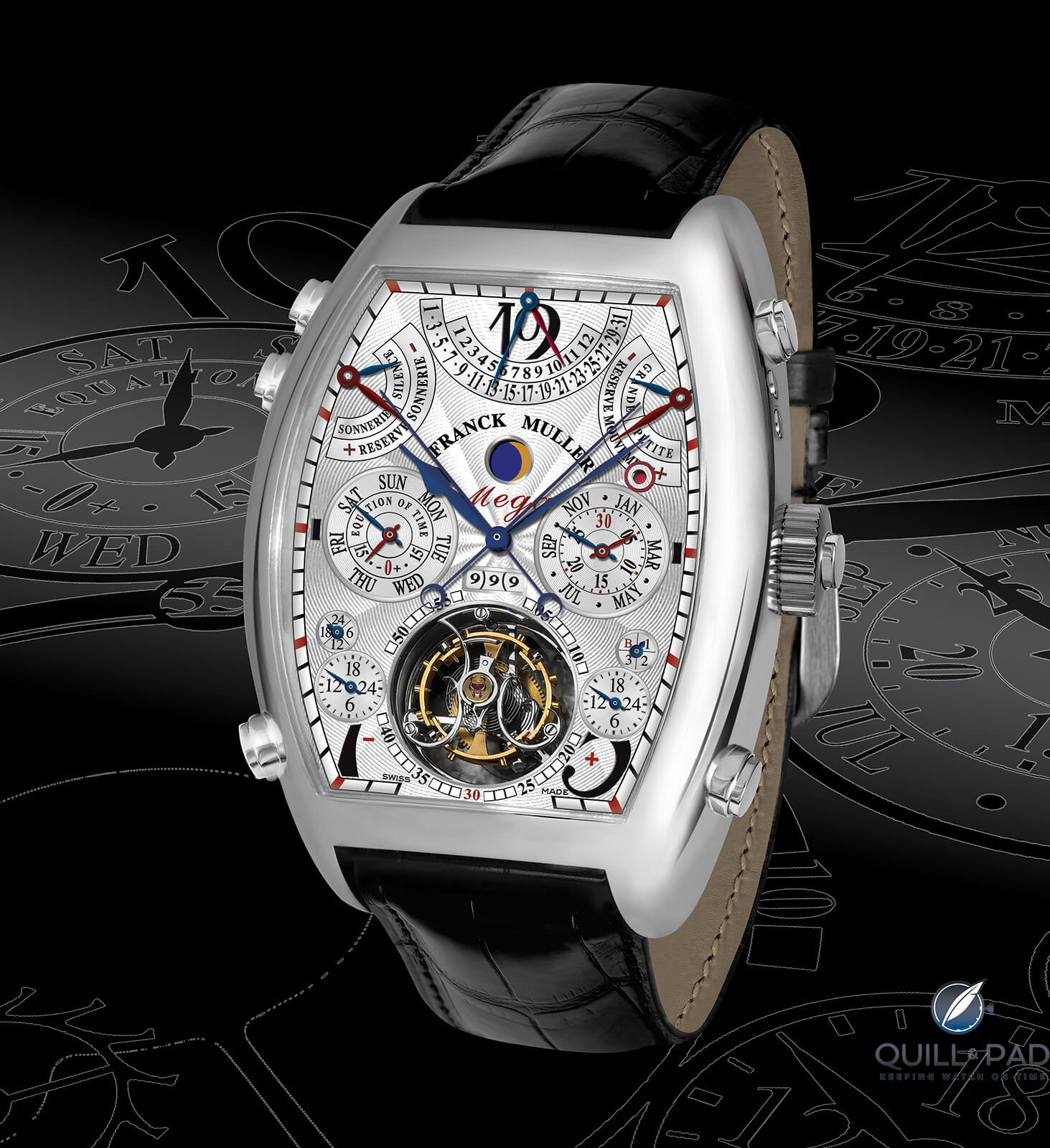
Franck Muller Aeternitas Mega
The other is the Franck Muller Aeternitas (“eternity” in Latin). Muller offers a step up from even that, the Aeternitas Mega. With 36 complications and 1,483 components, the company calls the Mega, “a wonder of micro-mechanic and watchmaking know-how.”
It is said to follow a thousand-year cycle that’s capable of being renewed to eternity.
More perpetual calendars of note
Patek Philippe
Patek Philippe has an enormously rich history in making some of the world’s finest perpetual calendar watches. The company combined its mastery of automatic winding with perpetual calendar technology in 1962, introducing the first automatic perpetual, Reference 3448.
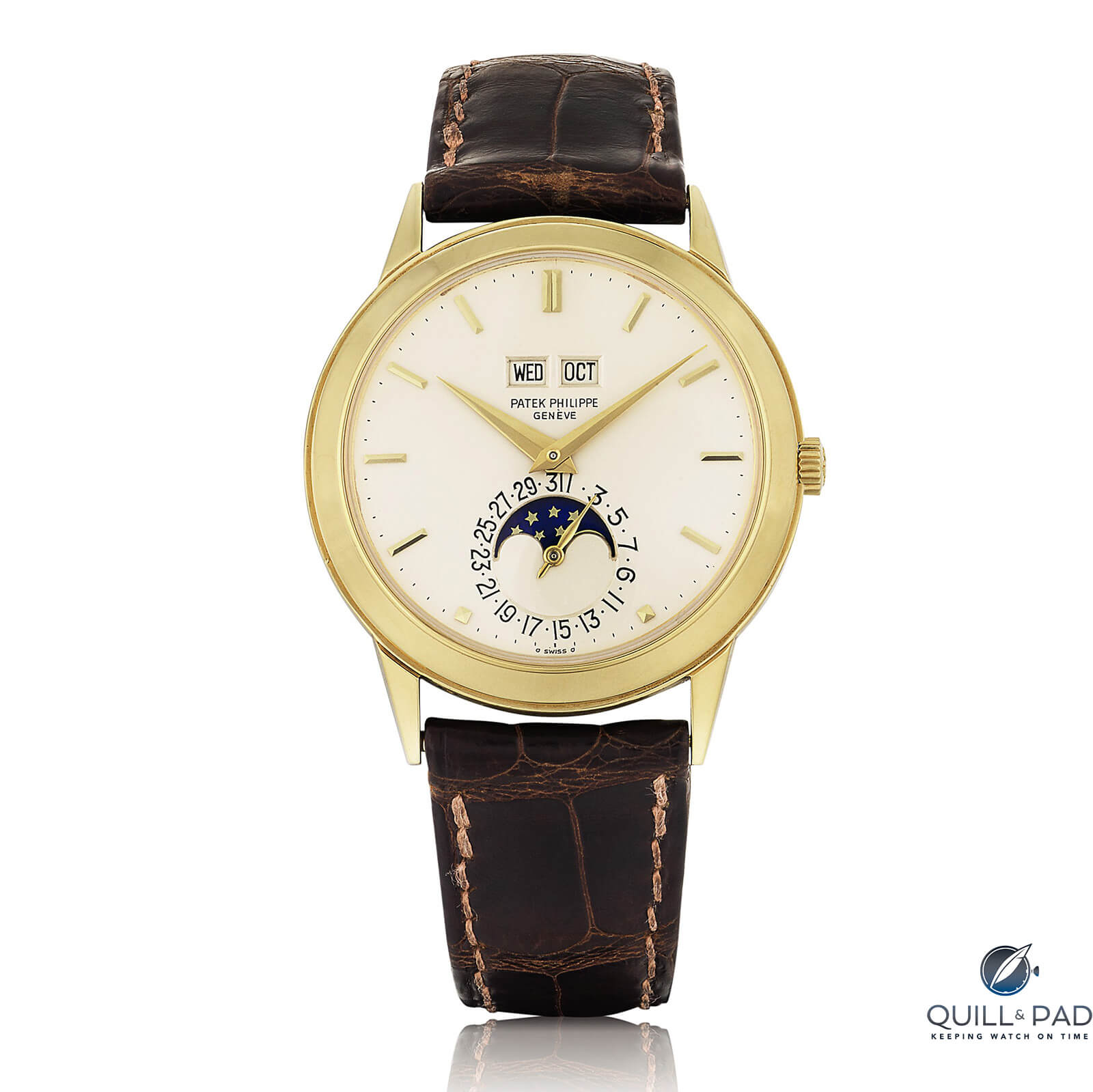
Patek Philippe Reference 3448 (photo courtesy Sotheby’s)
The company seems to like combining a moon phase with most of its perpetual calendars. Essentially, this links both the motion of the moon around the earth with the earth’s motion around the sun.
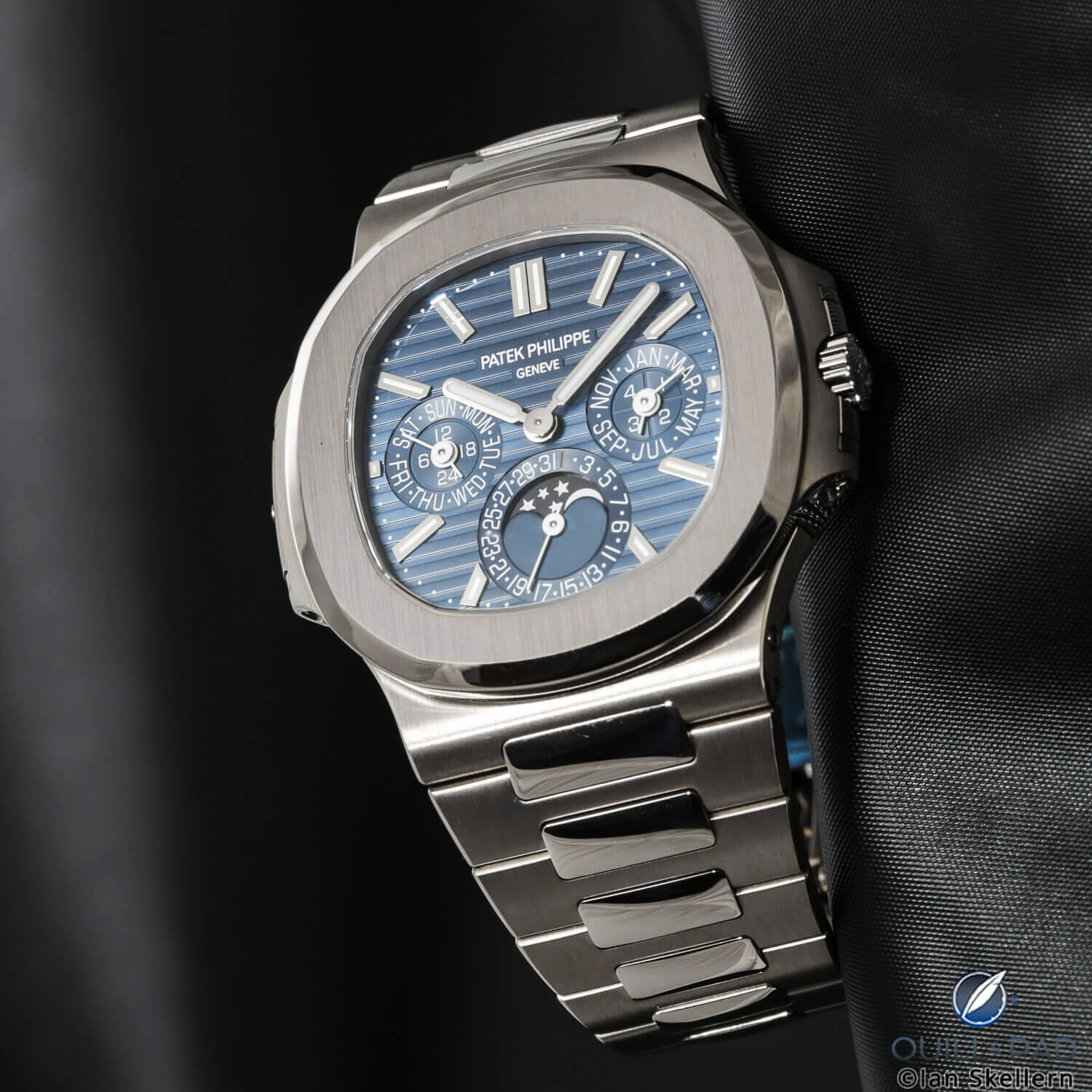
Patek Philippe Nautilus Perpetual Calendar Reference 5740
Most collectors have their favorites in Patek Philippe’s inventory of complications. One of mine is the Nautilus Perpetual Calendar Reference 5740/1G. This piece ticks all the boxes with its blue/black face showing the month, day, date, moon phase, and position in the leap year cycle.
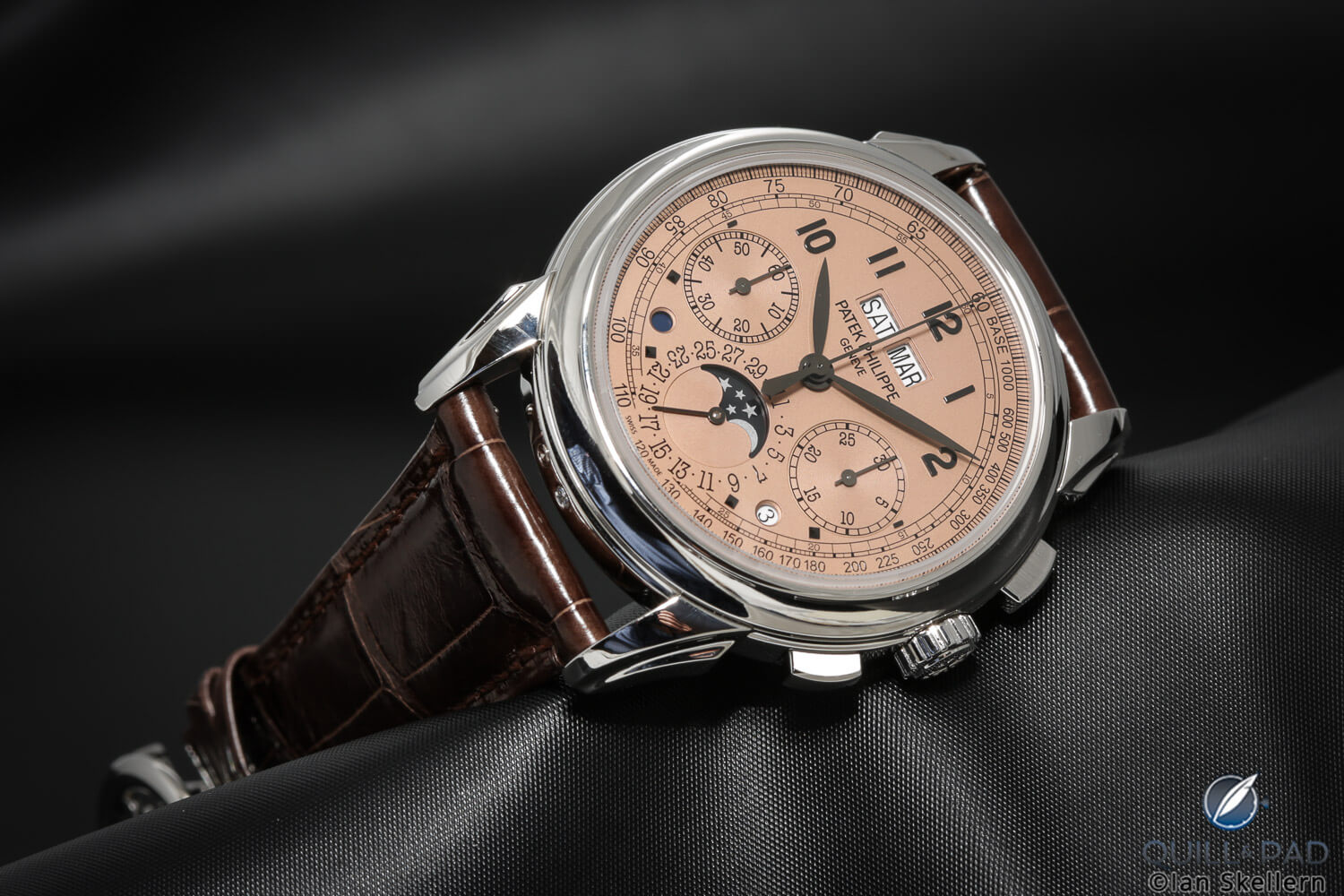
Patek Philippe Ref 5270P Perpetual Chronograph
Another of my favorites with a much different layout is the Patek Philippe 5270P-001 with its salmon-colored dial displaying the month and day in prominent aperture windows; the date, moon phase, and leap year cycle are also shown in small windows. Along with all of that, the 5270P also sports a chronograph.
Breguet
Breguet has been making perpetual calendar watches since the eighteenth century. The company’s dial layout imparts a lot of information in a small space of just 40 mm. Generally, Breguet’s perpetual calendars favor traditional subdials showing the month, day, date, and leap year continuum. They also include a beautifully engraved moon phase display.
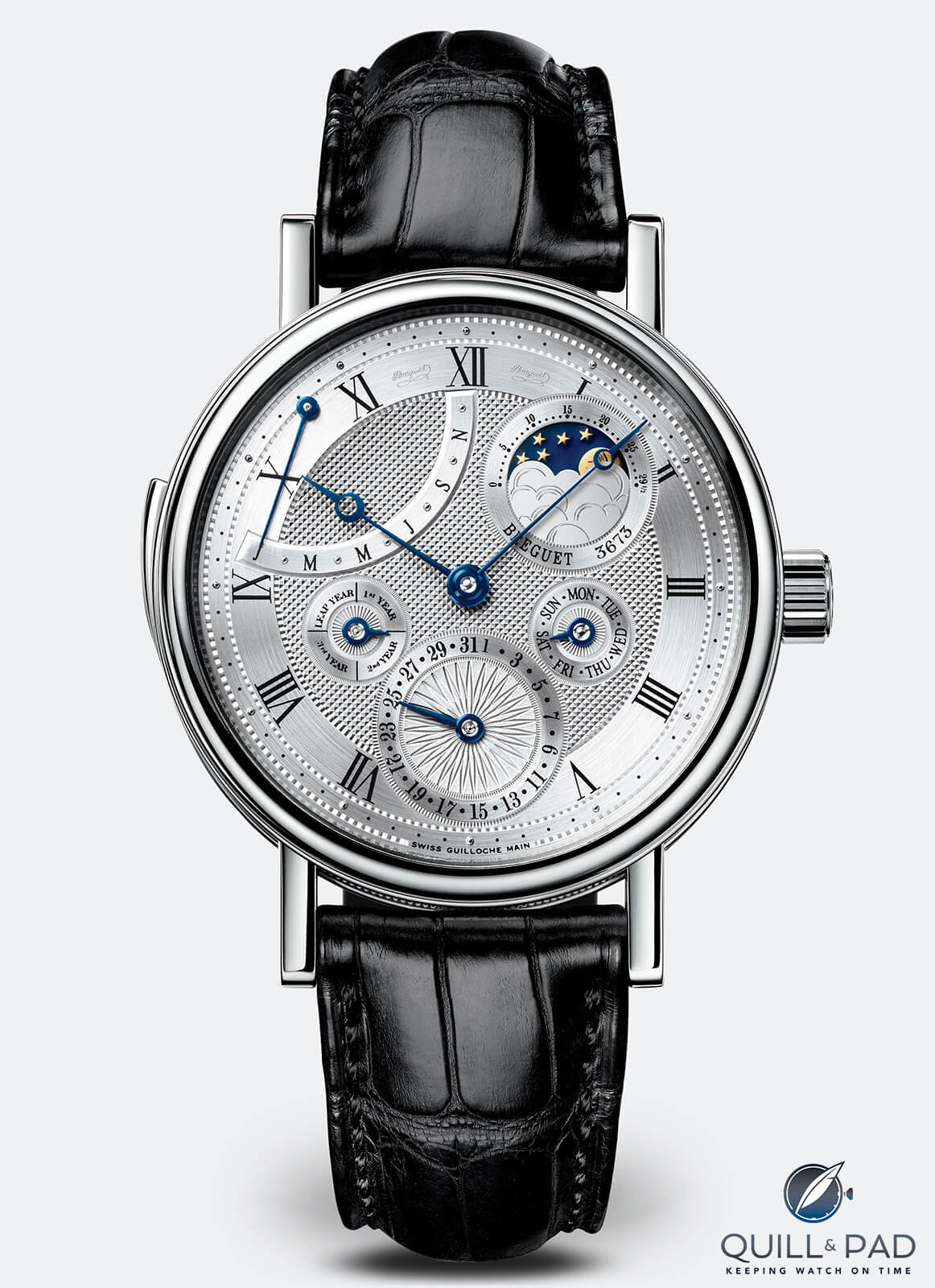
Breguet Classique Reference 5447 perpetual calendar
Breguet is easily recognized. The ribbon-straight lugs offer the first clue. The layout is classic and uniquely its own. My favorite Breguet perpetual calendar is the Classique Reference 5447. It is a straight, no-nonsense perpetual indicating just what is required to fulfill its four-year cycle time after time.
There is one catch, though. The Breguet is a manual-wind piece. And the power reserve is only 40 hours for this most classic of timepieces. This watch requires some attention. If you forget the daily winding ritual and it runs down, you will have to reset it with the four pushpieces controlling the various calendar displays.
This watch is elegantly old school. As Breguet says, “It embodies . . . purity of form, harmony of proportion, and clarity of information.”
Bovet
For some time now I’ve had a soft spot for Bovet and Pascal Raffy, the man behind the manufacture (see Accidents Happen: Inside The Horological Emergency Room At Bovet).
Admittedly, these pieces reach the upper end of the price spectrum – even for perpetual calendars. Two of my favorites from Bovet include the following.
Bovet Récital 22 Grand Récital
At a cost of more than $450,000, this is a serious collector’s piece. It demonstrates the merging of horological art and astronomical science. Truly, a beautiful piece.
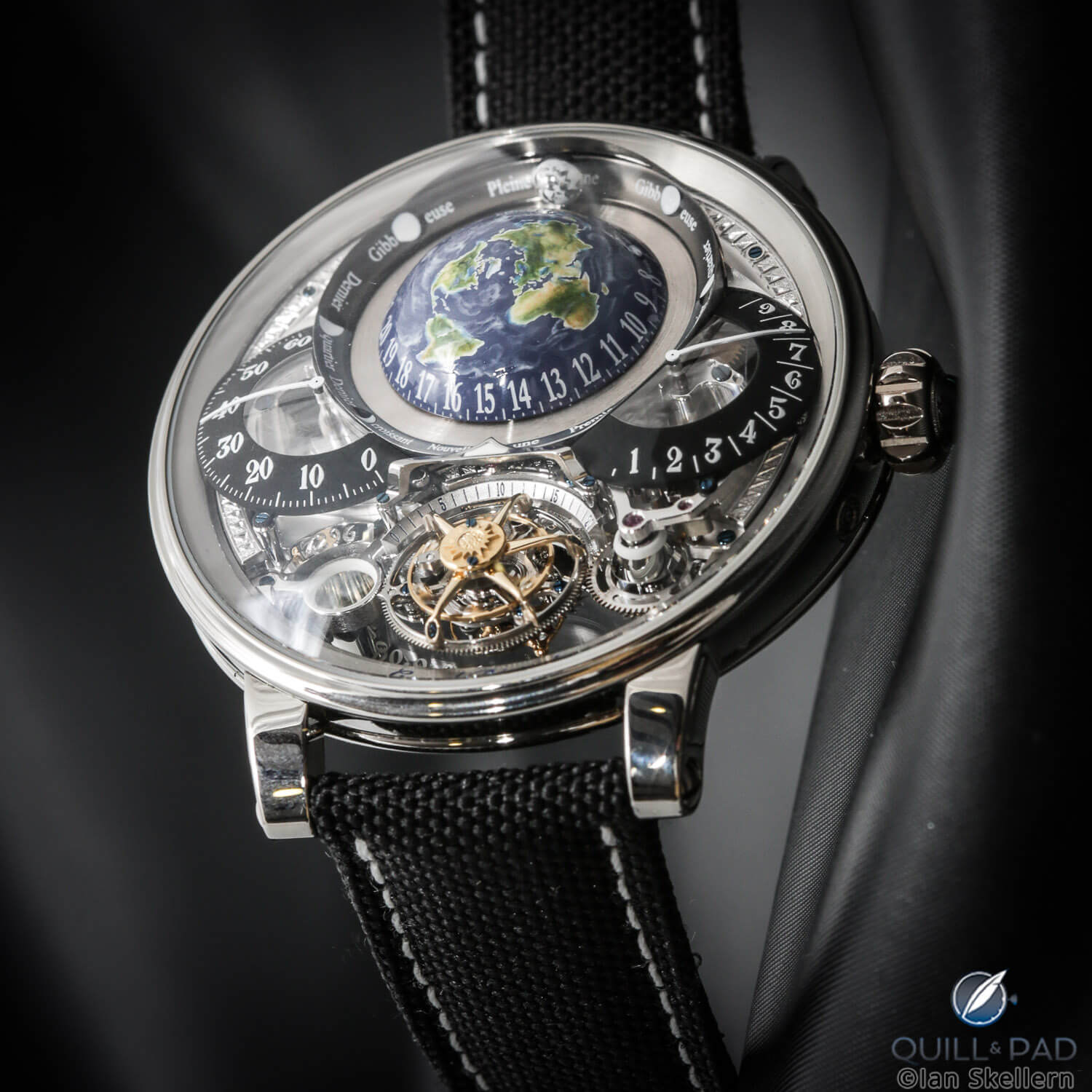
Bovet 1822 Récital 22 Grand Récital
And complicated. It has the traditional correctors used to adjust each display individually. However, it has something else that’s both unique and incredibly convenient. The Bovet engineers developed a pushpiece located between the upper lugs that simultaneously adjusts all the timepiece’s functions. So if the watch has been stopped for four days, just press this pushpiece four times and the perpetual calendar and tellurium functions adjust simultaneously.
Bovet Récital 21 Perpetual Calendar with retrograde date
The Bovet Récital 21 Perpetual Calendar with retrograde date is one of the simpler models in the Recital collection. Adding interest is the sloped case – what Raffy calls the writing desk slope case.
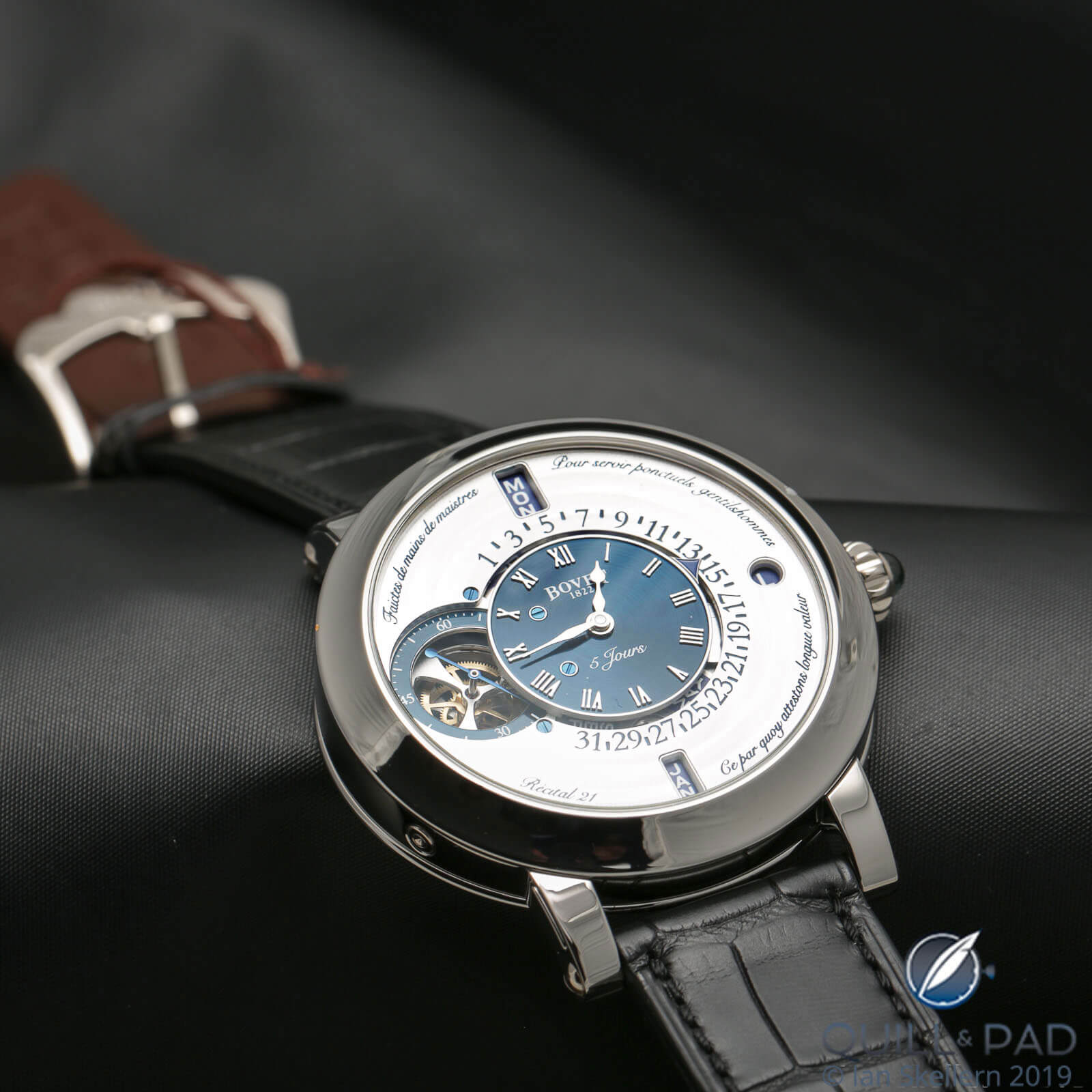
Bovet Récital 21 in titanium
Like all Bovet movements, the one powering this watch is hand-decorated to the most exacting standards. The blue dial showcases Bovet’s artisanal virtuosity. The designers chose a blue circular brushed finish on the central subdial for hours and minutes and the cutaway for seconds.
Since first introduced in 2015, this dial treatment has been a standout both in color and depth. Note also how the seconds subdial and hand sweeps under the central dial. It’s a clever design feature, one not often seen.
De Bethune DB25 Perpetual Calendar
The DB25 is De Bethune’s designated calendar collection. The pieces in this collection all employ the same base caliber but different case metals and dials.
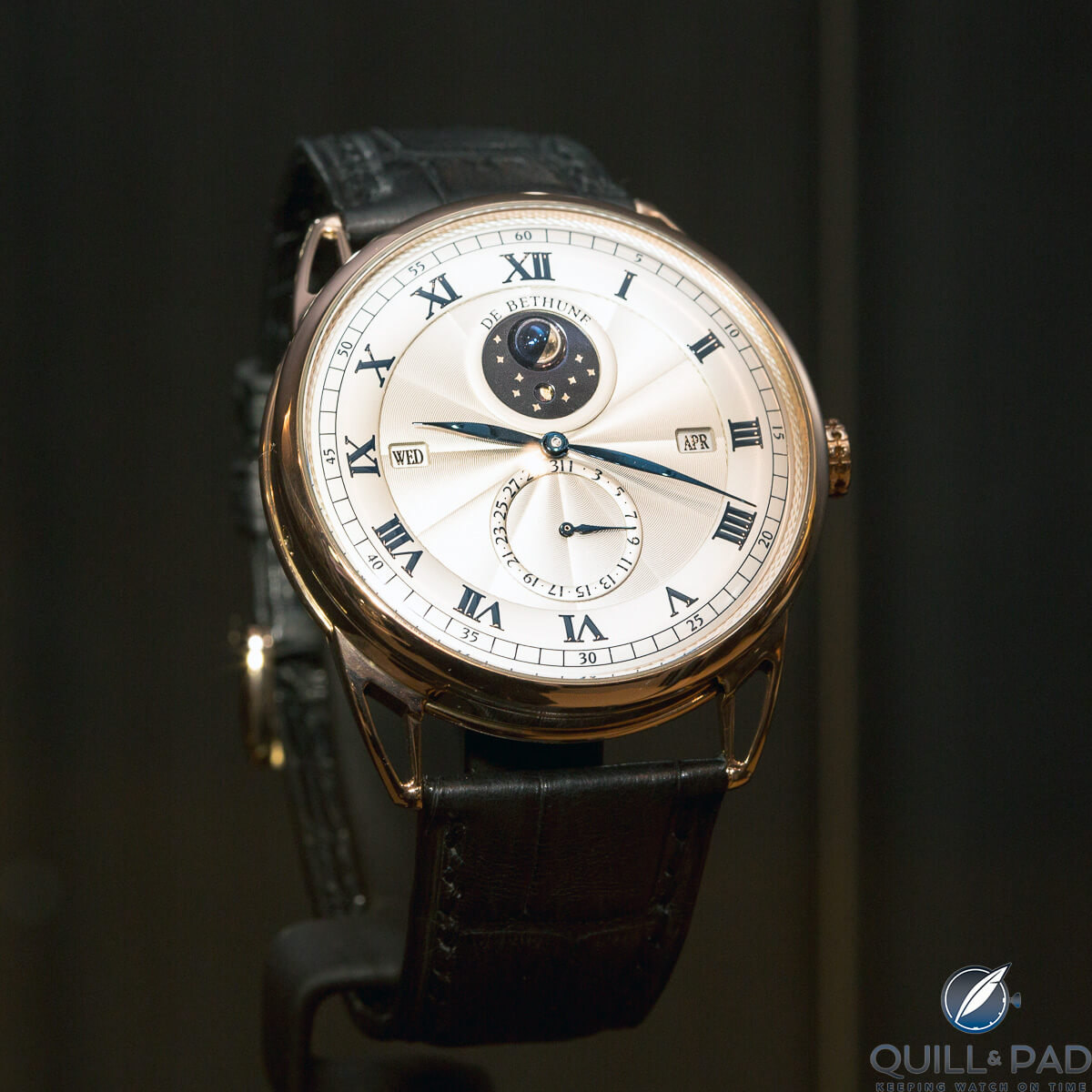
De Bethune DB25 Perpetual Calendar
The DB25 Perpetual Calendar provides the classic perpetual calendar information: day, date, month, and leap year designator. For the DB25, De Bethune used a leap year indication aperture nestled at 12 o’clock in the moon phase subdial.
The hands are also curved, an oft-seen De Bethune design feature. It adds another dimension of artistry to the piece.
Within this collection, my favorite is reference DB25QPAWS8 with white gold case and anthracite dial. It shows an understated, yet extraordinarily elegant combination of colors and function.
Greubel Forsey QP à Équation
One of the most innovative perpetual calendars of recent years is the Greubel Forsey QP à Équation.
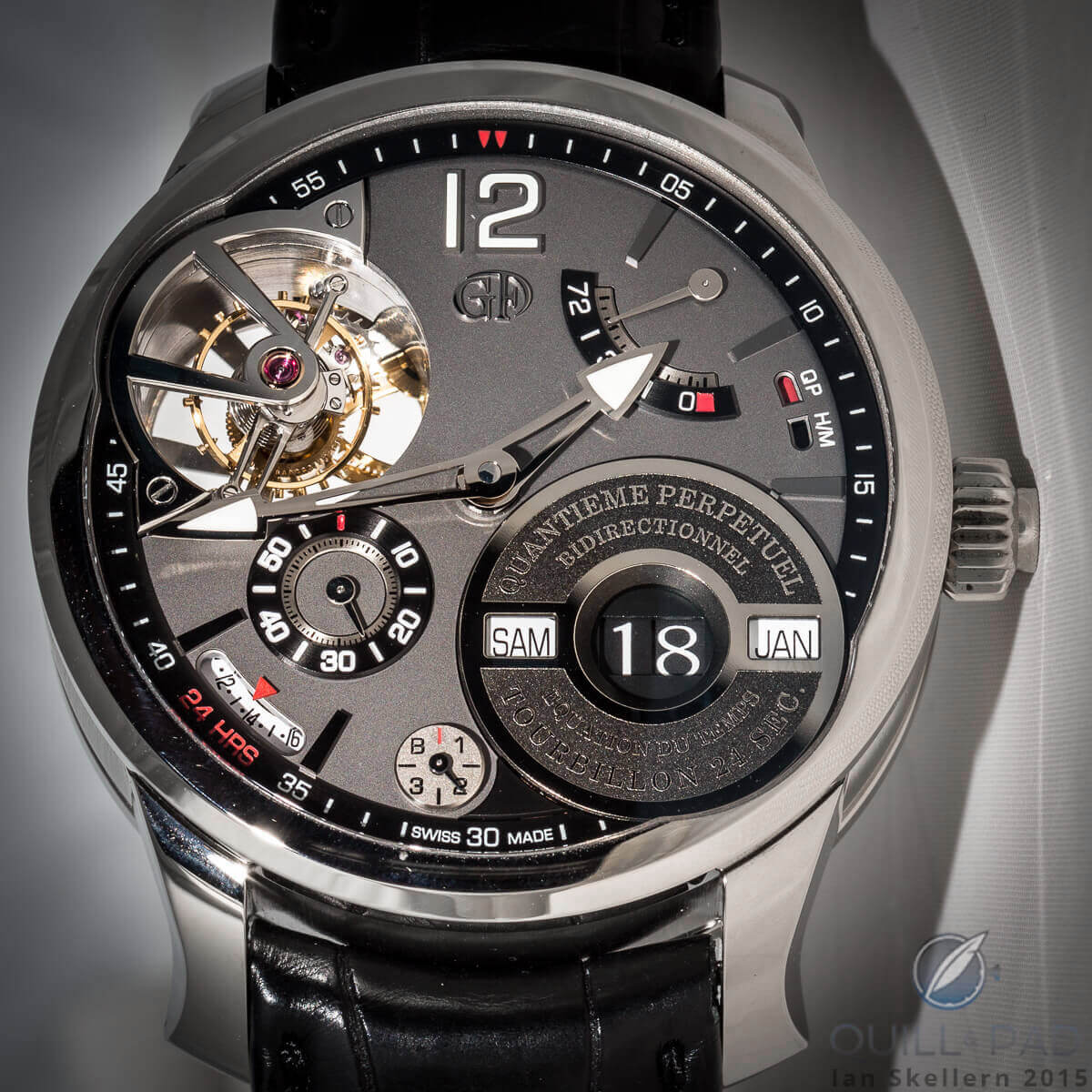
Greubel Forsey Quantième Perpétuel à Équation: note the ease of reading day, (big) date, and month in a straight line
As well as offering an equation of time indication, its calendar displays are read linearly day-date-month and all functions can be set easily both forwards and backwards so no messing around with individual pushers.
Conclusion
The perpetual calendar is an engineering achievement. Wearing one makes a statement about the owner’s horological knowledge, taste, and respect for the craft.
Perpetual calendars are informative, but they also provide a benchmark for where the business of watchmaking has evolved since the first Thomas Mudge perpetual calendar pocket watch in 1762. Then in 1925 when Patek Philippe developed the first perpetual calendar wristwatch. And today, where we see the same information conveyed in increasingly sophisticated styles and applications.
Quick Facts Jaeger-Le Coultre Master Ultra Thin Perpetual Enamel reference 13035E1
Case: 39 x 10.44 mm, white gold
Dial: blue enamel over guilloche, applied hour markers
Movement: automatic Caliber 868A/2, 46-hour power reserve, 28,800 vph/4 Hz frequency
Functions: hours, minutes, hacking seconds; perpetual calendar with month, day, date, four-digit year, moon phases in both hemispheres
Limitation: 100 pieces
Price: $53,000 / €55,000
You may also enjoy:
Annual Calendars Are Goldilocks Complications: Not Too Hot, Not Too Cold, Just Right
5 Fantastic Perpetual Calendars Perfect For February 29, 2020
Leave a Reply
Want to join the discussion?Feel free to contribute!



So many fascinating watches, so many detailled information, what a pleasure to read, dear Chris. Special article for a special year. Thank you very much. I loved to see Jaquet Droz and Breguet because of their amazing elegance.
Regards, Thomas
You left out Ochs & Jr. In Lucerne Switzerland.
They have some of the most accurate watches of this type.
Ochs und Junior actually made its name and reputation with the annual calendar. I believe there is now a perpetual in the lineup, but it hasn’t been there very long.
Great read, thank you. One of my favourites of the kind that accounts for secular years is the IWC Il Destriero Scafusia. Was this the first?
Hello Justin, I believe it was! But you might know that better than I do, actually.
Of recent note – from 1970 on – are the perpetual calibers that quartz has powered, and the industry has invented quite a few movements in the last 45 years that incorporate a perpetual complication. Of note, the lack of intermeshed gears and hands which are not connected to the stem has become commonplace. Electric pushers moving the hands are now rote, which allows a watch with power saving mode to wake up, adjust it’s display, correct to the date, hour, minute, second, and do this over and over during it’s power reserve. Said reserve is now measured in 100’s of days with solar, rather than dozens of hours with mechanicals, and with the intrinsic accuracy of quartz, you arrive at a watch only needed DST changes duriing the year, if at all, with an annual correction of a handful of seconds, vs. COSC certified watches allowing up to 40 seconds a week.
Our goalposts have moved, exceedingly, however, the marketing of high end watches hasn’t changed as they are exhibitions of status and style among those with the disposable income to participate. As long as human ego is involved, high end watches will sell – unless of course someone needs an accurate watch with instant reference to the time on their wrist. And that is where the rest of the market will still be supplied by the mass producers who continue to innovate and lower the bar to the possession of complications once considered completely out of the reach of the common man.
Interesting article! I’ve been curious about perpetual calendars for a while now, and this post helped clarify what they can and can’t do. Thanks for sharing!
This post on perpetual calendars is fascinating! I love how it broke down the various functions and features that many models overlook. It’s interesting to see the blend of craftsmanship and technology, but it also makes me wonder about the future of watchmaking—will we always need these intricate designs in an age of smart devices? Thanks for the insightful read!